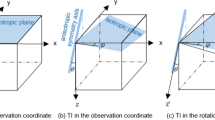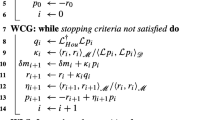Abstract
In 2D anisotropic media, non-stationary filters and low-rank approximation methods are classical strategies to compute the decomposition operators, but they suffer from expensive computational costs for 3D media. This study adopts the eigenform analysis into 3D vertical transverse isotropic (VTI) media and produces the separated vector P and S wavefields with the same amplitudes, phases, and physical units as the input elastic wavefields. We first built a 3D zero-order pseudo-Helmholtz decomposition operator by deriving the eigenvalues and eigenvectors of the 3D VTI wave equations in the wavenumber domain. The eigenvalues refer to the phase velocities of P-, SH-, and SV-wave, and the corresponding eigenvectors are pointing to their polarizations. Second, we use the pseudo-Helmholtz decomposition operator to construct a 3D anisotropic Poisson’s equation. Based on the laterally homogeneous assumption, Poisson’s equation is solved in the mixed domain \(z - k_{x} - k_{y}\), where \(k_{x}\), \(k_{y}\), and \(z\) denote the horizontal wavenumbers and depth, respectively. Third, we obtain the vector P and S wavefields using the proposed 3D pseudo-Helmholtz decomposition operator in the space domain. Lastly, 3D PP and PS images are calculated with a dot-product imaging condition. The anisotropic amplitude versus offset (AVO) responses of the 3D elastic reverse-time migration (ERTM) images are also validated by analytical solutions (Ruger’s equations). Our proposed 3D pseudo-Helmholtz decomposition operator degrades to a gradient operator satisfying isotropic media conditions. In addition, the method is easy to extend into 3D due to its high-efficiency cost. Several numerical examples with large shear anisotropy are selected to demonstrate the feasibility of our proposed pseudo-Helmholtz decomposition method in 3D applications.






















Similar content being viewed by others
References
Aki K, Richards P (2002) Quantitative Seismology. W. H. Freeman
Caldwell J (1999) Marine multicomponent seismology. Lead Edge 18:1274–1282. https://doi.org/10.1190/1.1438198
Cheng J, Fomel S (2014) Fast algorithms for elastic-wave-mode separation and vector decomposition using low-rank approximation for anisotropic media. Geophysics. https://doi.org/10.1190/geo2014-0032.1
Crase E, Pica A, Noble M, Mcdonald J, Tarantola A (1990) Robust elastic nonlinear waveform inversion: application to real data. Geophysics 55:527. https://doi.org/10.1190/1.1442864
Dellinger J, Etgen J (1990) Wave-field separation in two-dimensional anisotropic media. Geophysics 55:914. https://doi.org/10.1190/1.1442906
Deng F, McMechan GA (2008) Viscoelastic true-amplitude prestack reverse-time depth migration. Geophysics 73:S143. https://doi.org/10.1190/1.2714334
Du Q, Gong X, Zhu Y, Fang G, Zhang Q (2014) 3D PS-wave imaging with elastic reverse-time migration. Geophysics 79:S173–S184. https://doi.org/10.1190/geo2013-0253.1
Granli JR, Arntsen BR, Sollid A, Hilde E (1999) Imaging through gas-filled sediments using marine shear-wave data. Geophysics 64:668. https://doi.org/10.1190/1.1444576
Gu B, Ren Z, Li Q, Han J, Li Z (2019) An application of vector wavefield decomposition to 3D elastic reverse time migration and field data test. Comput Geosci 131:112–131. https://doi.org/10.1016/j.cageo.2019.07.001
Han J, Wang Y, Lu J (2013) Multi-component Gaussian beam prestack depth migration. J Geophys Eng 10:86–95. https://doi.org/10.1088/1742-2132/10/5/055008
Rüger A (2002) Reflection Coefficients and Azimuthal AVO Analysis in Anisotropic Media.
Sripanich Y, Fomel S, Sun J, Cheng J (2017) Elastic wave-vector decomposition in heterogeneous anisotropic media. Geophys Prospect 65:1231–1245. https://doi.org/10.1111/1365-2478.12482
Stewart RR, Gaiser JE, Brown RJ, Lawton DC (2003) Converted-wave seismic exploration: applications. Geophysics 68:40–57. https://doi.org/10.1190/1.1543193
Sun R, Chow J, Chen K (2001) Phase correction in separating P- and S-waves in elastic data. Geophysics 66:1515–1518. https://doi.org/10.1190/1.1487097
Sun R, McMechan GA, Lee CS, Chow J, Chen CH (2006) Prestack scalar reverse-time depth migration of 3D elastic seismic data. Geophysics 71:S199–S207. https://doi.org/10.1190/1.2227519
Sun R, McMechan GA, Chuang HH (2011) Amplitude balancing in separating P- and S-waves in 2D and 3D elastic seismic data. Geophysics 76:S103. https://doi.org/10.1190/1.3555529
Tang C, McMechan GA (2018) Elastic reverse time migration with a combination of scalar and vector imaging conditions. SEG Tech Progr Expand Abstr. https://doi.org/10.1190/segam2018-2998139.1
Tang J, Huang Y, Xu X, John T, James H (2009) Application of converted-wave 3D/3-C data for fracture detection in a deep tight-gas reservoir. Lead Edge 28:826. https://doi.org/10.1190/1.3167785
Thomsen L (1986) Weak elastic anisotropy. Geophysics 51:1954–1966. https://doi.org/10.1190/1.1442051
Tsvankin I (2012) Seismic signatures and analysis of reflection data in anisotropic media, 3rd edn. Society of Exploration Geophysicists.
Wang W, McMechan GA (2015) Vector-based elastic reverse time migration. Geophysics 80:S245–S258. https://doi.org/10.1190/geo2014-0620.1
Wapenaar CPA, Haimé GC (1990) Elastic extrapolation of primary seismic P- and S-waves1. Geophys Prospect 38:23–60. https://doi.org/10.1111/j.1365-2478.1990.tb01833.x
Yan J, Sava P (2009), Elastic wave-mode separation for VTI media. Geophysics, 74: WB19. https://doi.org/10.1190/1.3184014
Yan J, Sava P (2007) Elastic wavefield imaging with scalar and vector potentials. SEG Tech Progr Expand Abstr. https://doi.org/10.1190/1.2792913
Yan J, Sava P (2008) Isotropic angle-domain elastic reverse-time migration. Geophysics 73:S229–S239. https://doi.org/10.1190/1.2981241
Yang J, Zhu H, Wang W, Zhao Y, Zhang H (2018) Isotropic elastic reverse time migration using the phase- and amplitude-corrected vector P- and S-wavefields. Geophysics 83:1–106. https://doi.org/10.1190/geo2018-0023.1
Yang J, Zhang H, Zhao Y, Zhu H (2019) Elastic wavefield separation in anisotropic media based on eigenform analysis and its application in reverse-time migration. Geophys J Int 217:2. https://doi.org/10.1093/gji/ggz085
Zhang Q, McMechan GA (2010) 2D and 3D elastic wavefield vector decomposition in the wavenumber domain for VTI media. Geophysics 75:D13. https://doi.org/10.1190/1.3431045
Zhao Y, Li W (2018) Model-based radiation pattern correction for interferometric redatuming in 4D seismic. Geophysics 83:1–50. https://doi.org/10.1190/geo2017-0731.1
Zhao Y, Zhang H, Liu H, Zhang D, Sengupta M (2018a) Target-oriented diversity stacking for virtual-source imaging and monitoring. Lead Edge 37:764–773. https://doi.org/10.1190/tle37100764.1
Zhao Y, Zhang H, Yang J, Fei T (2018b) Reducing artifacts of elastic reverse time migration by the deprimary technique. Geophysics 83:S569–S577. https://doi.org/10.1190/geo2018-0260.1
Zhu H (2017) Elastic wavefield separation based on the Helmholtz decomposition. Geophysics 82:S173–S183. https://doi.org/10.1190/GEO2016-0419.1
Acknowledgments
We appreciate the help of the Editor and the anonymous reviewers for their comments and suggestions. These significantly improve the quality of this paper. This study is jointly supported by the National Key R&D Program of China (2017YFC1500303), the Science Foundation of China University of Petroleum, Bei**g (2462019YJRC007 and 2462020YXZZ047), and the Strategic Cooperation Technology Projects of CNPC and CUPB (ZX20190220, and Sinopec Joint Key Project (U19B6003-004), and NSFC National Natural Science Foundation of China (42104108), China Postdoctoral Science Foundation (2021M703576).
Author information
Authors and Affiliations
Contributions
Dr. Jiahui Zuo developed the theory and validated them with numerical computations, and wrote a preliminary manuscript. Dr. Yang Zhao improved the theory, numerical simulations and provided English language editing issues as the corresponding author. The authors have no conflicts of interest to declare that are relevant to the content of this article. All authors approved the final version of the review paper.
Corresponding author
Additional information
Publisher's Note
Springer Nature remains neutral with regard to jurisdictional claims in published maps and institutional affiliations.
Appendix
Appendix
Assuming the eigenvalue of the matrix \({\text{A}}\) is \(\lambda\) with the corresponding eigenvector (\(x_{1} ,x_{2} ,x_{3}\)), so we have
For the first equation of (A1), if set \(x_{3} = 1\), we obtain
Then inserting Eq. (A2) into the second equation of (A1), we obtain
Finally, substituting the knowing eigenvalue \(\lambda_{3}\) into Eqs. (A2) and (A3), we have the eigenvector \(\hat{a}_{3}\).
If set \(x_{2} = 1\), we obtain
Then inserting Eq. (A4) into the third equation of (A1), we obtain
After substituting \(\lambda_{2}\) into Eqs. (A4) and (A5), we have the eigenvector \({\hat{\text{a}}}_{2}\).
If set \(x_{1} = 1\) for the second part equation of (A1), we obtain
And inserting Eq. (A6) into the third part of Eq. (A1), we obtain
In the same way, we have the eigenvector \({\hat{\text{a}}}_{1}\) with \(\lambda_{1}\).
The eigenvalues \(\lambda_{1}\), \(\lambda_{2}\), and \(\lambda_{3}\) of Eq. (A1) is determined by \(\left| {\lambda E - {\text{A}}} \right| = 0\) being rewritten as
Solving Eq. (A8), then the eigenvalues are
Replacing the stiffness coefficients with the Thomsen parameters, Eq. (A9) can be simplified as
Based on the weak anisotropy hypothesis, we approximate the square-root term using the first-order Taylor expansion. Eq. (A10) can be simplified as Eq. (4).
Rights and permissions
About this article
Cite this article
Zuo, J., Niu, F., Liu, L. et al. 3D Anisotropic P- and S-Mode Wavefields Separation in 3D Elastic Reverse-Time Migration. Surv Geophys 43, 673–701 (2022). https://doi.org/10.1007/s10712-021-09688-8
Received:
Accepted:
Published:
Issue Date:
DOI: https://doi.org/10.1007/s10712-021-09688-8




